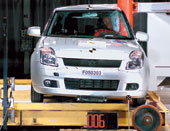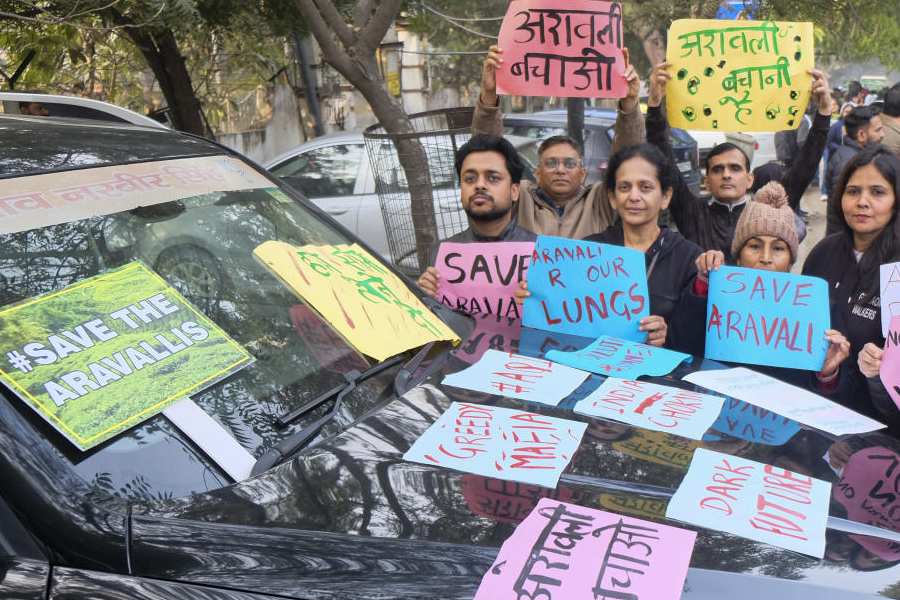 |
Just how safe is your car? The talking points are usually performance and handling, how quickly the car can zoom from zero to 100, or say, the time it takes to go from 30kmph to 50kmph in third gear. But have you considered how your car will react in an accident? How safe or unsafe will the occupants be? What happens if it hits another car head on or will it survive a glancing blow? How strong is it in the case of a side impact? The answers can be quite disturbing and let?s face it, nobody really wants to find out, at least not in real life. Yet, the safety of you and your car is something that needs to be determined. But how? After all, nobody wants to put life and limb at risk.
The solution lies in crash testing. This is something car manufacturers inform you about only if their product has performed well and not when it hasn?t met the mark. It?s not like a pack of cigarettes, carrying a mandatory warning about them being injurious to health. Imagine the reaction if a prospective car buyer was greeted at the dealer?s by a banner proclaiming ?Driving this car could be injurious to your health?!
Let?s consider one of the best-known crash test programmes out there. The European New Car Assessment Program (NCAP) is a programme, which subjects cars to rigorous crash testing exams and the results are regarded highly by both manufacturers and consumers. Primarily, there are four tests a car is subjected to: frontal impact, side impact, a pole impact test and pedestrian impact protection.
In the frontal impact test, a car strikes a deformable barrier that is offset. The impact takes place at 64kmph and the barrier is offset because not all frontal impacts are absolutely head-on. In the side impact test, a trolley fitted with a deformable front is towed into the driver?s side of the car to simulate a side-on crash. This is done at a speed of 50kmph. The pole impact test is also a side impact test but here, the car is propelled into a narrow pole and the deformation is measured. Measurements are taken from highly-sophisticated dummies packed with sensors to record every detail both at the time of impact and after.
The Euro NCAP tests are predominantly Europe-centric but as a lot of the cars sold in Europe are also beginning to be sold here in India, it would be interesting to see how the cars coming into the country actually measure up.
In the news right now are two new cars ? the Suzuki Swift that was launched recently and the Hyundai Getz that was introduced a few months ago. Both marques were put through the paces at the Euro NCAP tests.
The overall verdict on the Swift was that it put in a sound all-round performance. The body proved to be extremely strong, suffering minimal deformation in the frontal impact and providing good protection for adults throughout. But protection for child occupants was mixed: it proved fairly good for the older child but less so for a younger one. Its ability to safeguard pedestrians and other vulnerable road users was judged to be reasonably good. One should keep in mind that this result would apply to the ZXi version in India only and that the ZXi lacks a head curtain bag while the test car was equipped with one.
Did the Getz manage to pick up as many points at the Euro NCAP tests? After testing, it was found that overall, the Getz turned in a reasonably balanced performance to gain its four-star rating. The frontal impact test showed the body structure to be stable. However, it was noted that severe distortion of the rear footwell had occurred. Restraint systems in the test car included single-stage tethered airbags for the driver and passenger, seat-mounted thorax and head airbags, and front seat belts with pre-tensioners and load limiters. In-car protection for children was good, but the Getz was found to have done little to safeguard pedestrians.
In the same category as the Getz is the Fabia from Skoda. And in this case too, the Euro NCAP tests showed the Fabia to be a strong small car that protects adult occupants pretty well. The pedestrian protection factor in the Fabia is similar to many cars of this size. Most of the benefits come from softer bonnet areas and from the fact that the glassed areas are seen as not giving rise to an increased risk of injury. Most of the front of the car was very stiff and unforgiving.
The fourth car perhaps also in this category is the Ford Fusion. The Fusion uses the same structure and running gear as the Fiesta Supermini. The passenger compartment proved strong and suffered only minimal deformation in the frontal impact. However, the driver and front passenger ran some risk of chest injury from high impact forces fed through to their chests from the seat belts. The car protected occupants reasonably in the side impact for a model without a thorax-protecting airbag. Child protection was judged fair while protection for pedestrians was similar to other cars of this size.
In the case of the Audi A6, recently launched in India, the Euro NCAP report hails its body as extremely strong and its stable passenger cell as secure enough to protect its adult occupants well. The car protected its child occupants, the body suffered minimal deformation and the driver?s door could be opened normally after the impact. However, where the Audi A6 lost points was in pedestrian protection. Only two sites on the bonnet top offered any protection to adult and child heads. The bumper and bonnet leading edge were deemed unfriendly to pedestrians and other vulnerable road users.
The Euro NCAP tests did not spare Mercedes either. And while it scored by having a body that is extremely stable and protects occupants well, the E-class did not protect pedestrians properly. The front of the car was very stiff even though a few points on the bonnet provided protection. Quite a dismal performance! That said, however, protection for children proved to be good and the restraints met almost every Euro NCAP performance standard.
The third German car that is available in India is the BMW 5-Series. Euro NCAP tested a RHD 520i and found that it has a very strong and stable passenger safety cage. But high loads were recorded by the driver dummy?s chest instrumentation in the frontal impact. Side impact protection was found to be a lot better though. Both child occupants were protected but the car?s ability to protect pedestrians was appalling. According to Euro NCAP, BMW needs to take the protection of pedestrians much more seriously than it did.
It would appear from these results that luxury car manufacturers are elitist in terms of car design, without factoring in the need for protecting pedestrians. However, the larger picture is that thanks to the Euro NCAP tests, one is now much better informed as to how his or her car stacks up in terms of various safety aspects. Remember, better safe than sorry!
My first car
 |
Krishna Mehta,
fashion designer
nThe first car I drove at the age of 16 was an Ambassador. I remember this clearly because it was a family car and naturally, when I started learning how to drive, it was my first option. But my first car in the true sense of the word, was a Standard Gazel gifted to me on my 18th birthday by my family after I got my license.
The car was one of those things that stuck with me all through my college days. It was a small car, which I drove to college daily, and it would break down quite often. I remember the brake wouldn’t work and I would bump into people and walls all the time. That said, however, I have some beautiful memories of the car. It is not in production any more and the only time I see it is in old films or photographs, where it never fails to bring a smile to my face. Since, then I have had many cars — a Mahindra Jeep; a Fiat; a Maruti and an Opel but nothing compares to the thrill of my Gazel.










